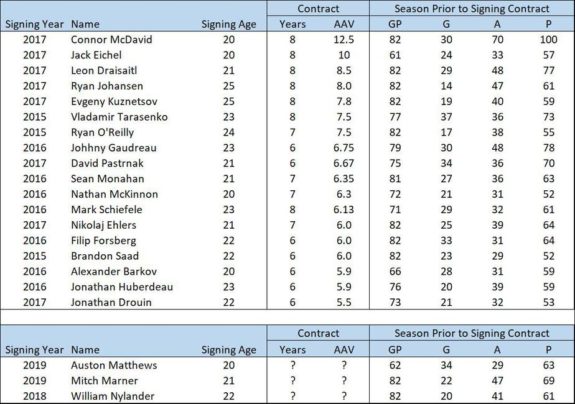John Tavares becomes an unrestricted free agent on July 1, and he’s the best free agent available by far, leading a group that includes John Carlson and not much else. There will be a lineup of teams looking to sign Tavares to a long-term, big money deal on July 1. Should the Toronto Maple Leafs be one of them? For that, we need to look at the Maple Leafs’ salary cap situation and whether or not they can afford him.

Maple Leafs’ Salary Cap Situation
The Toronto Maple Leafs find themselves in a unique salary cap situation. With a number of players coming off of the books (James van Riemsdyk, Tyler Bozak, Leo Komarov and Roman Polak to name a few) and the salary cap expected to rise from $75 million up to somewhere in the $78-$82 million range, the Leafs have a ton of cap space available for next season (over $20 million at the moment).
However, William Nylander has earned a significant raise from his entry-level contract this summer and Auston Matthews and Match Marner will get their big contracts next summer, so the abundant cap space is really only for one year.

There are a couple implications of the one-year-of-cap-space situation. First, it makes an aging veteran free agent like Joe Thornton attractive because you can sign him for a one-year deal. Second, it opens up the possibility for new general manager Kyle Dubas to get creative, such as offering to take on a bad contract from a cash-strapped team and receiving an up-and-coming player in return. An example of this from 2016 is the Carolina Hurricanes taking on the Bryan Bickell contract from the Chicago Blackhawks and receiving promising youngster Teuvo Teravainen as a reward.
The final implication (the one most important to this article) is that in order to judge whether or not the Leafs should sign a free agent like John Tavares, we really need to be looking at their 2019-20 salary cap situation. That involves making some assumptions, including what the salary cap will be (I’ll guess $84 million, up $9 million versus today thanks to all of the Vegas money) as well as what Nylander, Matthews and Marner will sign for.
Signing Matthews, Marner and Nylander
To estimate what the future contracts for Auston Matthews, Mitch Marner and William Nylander will look like, we need to analyze their comparables. Here is a list of young NHL star forwards that have signed long-term contracts in the past three years:

Looking at their position and stats prior to signing, the best comparable for Auston Matthews is the Jack Eichel contract (8 years x $10 million per year). William Nylander would be somewhere around the Nikolaj Ehlers/Filip Forsberg range (6 years x $6 million per year) and Mitch Marner around the Johnny Gaudreau/David Pastrnak range (6 years x $6.75 million). That’s a total of $22.75 million.
There are a couple other variables at play though. The Leafs’ youngsters have each had two excellent seasons, compared to Pastrnak and Ehlers, for example, who had just had one great season before signing. The fact that the salary cap is increasing will also push the Matthews, Marner and Nylander deals higher, but we don’t know how much. We also don’t know if the negotiations will settle on more or less term (i.e., longer or shorter length) and if the fact that they are all negotiating around the same time as one another will have any impact, so I’m going to be a bit conservative and assume the total cost of all three players will be $25 million per year.
A number of smaller negotiations for restricted free agents will be done over the next two years as well, including Kasperi Kapanen, Andreas Johnsson, Connor Carrick, Andreas Borgman and Garret Sparks. Assuming they all get reasonable, short-term deals, the Maple Leafs would have around $15 million in cap space left for the 2019-20 season.
Maple Leafs’ 2019-20 Depth Chart
If we assume that all of the Leafs’ restricted free agents stick around and the Leafs make no other moves (trades, free-agent signings, etc.), this is what the Maple Leafs 2019-20 depth chart will look like:

With $15 million in cap space to improve the above roster, what would you do with the money? By adding Tavares, you will have easily the best group of forwards in the NHL, but Nikita Zaitsev will be on your top defensive pairing and half of your starting defence will be fringe NHLers. That’s a scary thought. Even if you were to shed Matt Martin’s contract, you’d only have enough money left to re-sign Jake Gardiner or someone of equivalent value.
Should Dubas Offer Tavares a Contract?
If we knew for a fact that the Leafs could sign Erik Karlsson, Drew Doughty or Oliver Ekman-Larsson next year when those three become free agents, I would say that the Leafs should save their money for a big-name defenceman. But unfortunately, the Tavares decision comes first, and it’s too good an opportunity to pass up.
Kyle Dubas and the Toronto Maple Leafs should offer Tavares a seven-year contract worth an average of $10.5 million per year. That will not be the highest-value contract that Tavares is offered. If the salary cap does in fact increase by $5 million, that means that nearly every single team in the NHL will be capable of offering Tavares $10 million with just a small amount of maneuvering. Surely a team that’s desperate for a centre like the Montreal Canadiens will up the ante. $11 million is easily in play, and we may see something all the way up to the Connor McDavid $12.5-million-per-year contract.
The Maple Leafs should try to sell Tavares on the fact that they will be contenders for the entire length of his contract in Toronto, he’ll have the chance to bring a Stanley Cup to his hometown team and he’ll have the opportunity to skate on a line with playmaking wingers like Mitch Marner and William Nylander.

If he does end up signing the Maple Leafs’ offer (and I’d give it a 5 percent chance), the Leafs would instantly become a top contender for the Stanley Cup in 2018-19 while they’d still have Jake Gardiner and Ron Hainsey on defence, and Dubas would have 12 months to solve the puzzle of the 2019-20 defence, with options such as trading Nylander to get it done.